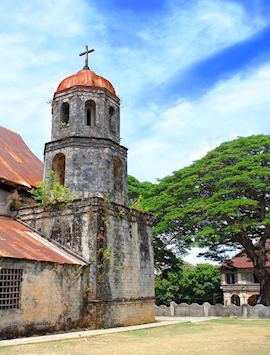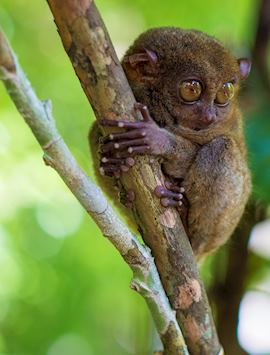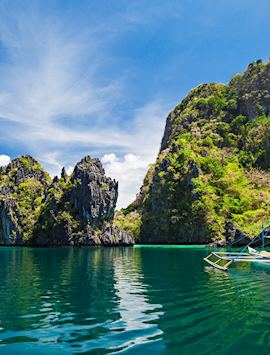The best time to visit the Philippines is from December to February, when temperatures are around 24°C to 31°C. At this time the country is fully accessible, including its many beautiful islands and more remote areas. Although the dry season lasts from November to April, temperatures are high during March and April, with highs of 34°C.
The wet season falls between May and October, but the rain isn’t constant and rarely impacts on travel plans. You’ll still enjoy hot, sunny days at this time (expect temperatures in the early thirties), with fewer crowds and lush, green scenery.
It’s worth noting the weather can be unpredictable in the Philippines. Typhoons can sometimes occur as early as August or as late as January.
Month-by-month guide for travelling in the Philippines
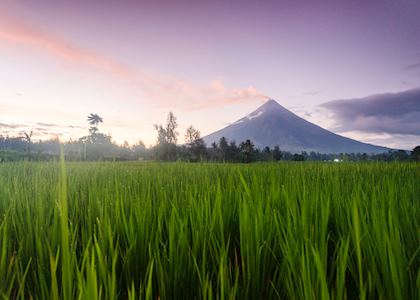
Visiting the Philippines in January
The month of January is an excellent time to travel to the Philippines, as temperatures are cooler without being too cold. It is also the height of the dry season, so rain should be minimal.
Events & Festivals
- Ati-Atihan (usually second week of January): Arguably the biggest festival in the country, taking place in Kalibo, Aklan province. Street dancing and wild costumes help celebrate an ancient land pact between settlers and indigenous Atis.
- Dinagyang (fourth week of January): A relatively modern festival based on the Ati-Atihan Festival and including a parade on the Iloilo River.
- Feast of the Black Nazarene (9th January): Devotees gather in the plaza outside Quiapo Church to touch the Black Nazarene — a life-size iconic statue of Christ, which is carried through the streets by a barefooted procession in Manila.
- Sinulog (third Sunday in January): The City's biggest annual event, held in honour of the Santo Niño (an image of Jesus as a child), featuring a huge street parade, live music, and plenty of food and drink in Cebu.
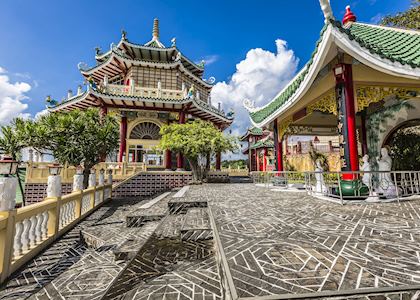
Visiting the Philippines in February
February is much the same as January; however, temperatures will be slightly higher and there will be fewer crowds after the rush of visitors at the start of the year.
Events & Festivals
- Kaamulan Festival (late February to early March): Taking place in Malaybalay City, Bukidnon, this ethnic festival celebrates the culture and tradition of the seven ethnic tribal groups that originally inhabited the area.
- Pamulinawen (first two weeks of February): A city-wide fiesta in Laoag City held in honour of St William the Hermit. Events include street parties, beauty pageants, concerts and religious parades.
- Panagbenga/Baguio Flower festival (third week in February): The summer capital's largest annual event, featuring parades of floats beautifully decorated with flowers from the Cordillera region. There are also flower-related lectures and exhibitions.
- Philippine Hot Air Balloon Fiesta (February): Pilots visit from around the world for this four-day event, providing balloon rides, microlight flying, skydiving and aerobatics displays in Clark, Pampanga.
- Suman Festival (third week in February): A mardi-gras-style extravaganza held in Baler, Aurora, featuring street parades, dancing and floats decorated with the native delicacy, suman — sticky rice cake rolled in banana leaves.
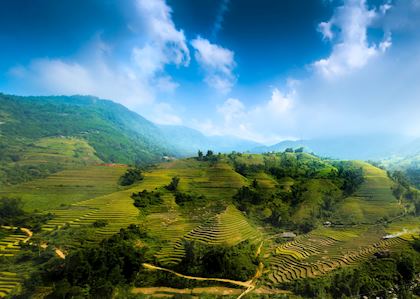
Visiting the Philippines in March
Temperatures start to pick up in March, but conditions are still at their peak for travel. Please be wary of Holy Week (around Easter), which may cause availability to be a major issue. This period is best avoided if having your pick of hotels is important.
Events & Festivals
- Arya! Abra (first or second week of March): Taking place in Bangued, Abra, highlights of this event include hair-raising bamboo-raft races along the frisky Abra River and the gathering of northern tribes.
- Bangkero Festival (first or second week of March): 'Bangkero' means 'boatmen', and this five-day festival along the Pagsanjan River is dedicated to all Bangkero, featuring parades, boat racing and street dancing.
- Kaamulan Festival (late February to early March): Taking place in Malaybalay City, Bukidnon, this ethnic festival celebrates the culture and tradition of the seven ethnic tribal groups that originally inhabited the area.
- Moriones (Easter weekend): A religious festival where locals wear masks and re-enact the story of a Roman centurion, Longinus, who was blind in one eye. Legend says that when he pierced Christ’s side with his spear, blood spurted into his eye and cured him.
- Pasayaw Festival (third week of March): A thanksgiving festival to God and St Joseph, with 12 barangays competing for honours in an outdoor dancing competition.

Visiting the Philippines in April
If travelling during the start of the month, please be sure to secure accommodation far in advance as the knock-on effect from Easter can cause disruption. Temperatures will be at their peak, this being the last month of the dry season.
Events & Festivals
- Allaw Ta Apo Sandawa (second week of April): The gathering of highland tribes in Kidapawan City, North Cotabato to pay respects to the sacred Mount Apo.
- Boracay International Dragon Boat Festival (April): A local version of Hong Kong’s dragon-boat races, featuring domestic and international teams competing in long wooden canoes on a course off White Beach in Boracay.
- Turumba Festival (April and May): A religious festival commemorating the seven sorrows of the Virgin Mary. The festival consists of seven novenas (acts of pious devotion), one for each sorrow, held at weekends in Pakil, Laguna.
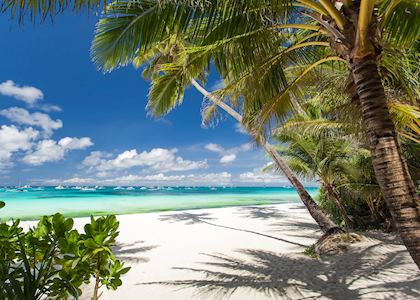
Visiting the Philippines in May
If you don't mind the heat, May is a great time to travel as there is still a high chance of dry weather throughout. Lowland areas can be extremely hot at this time of year, but this makes for a nice time to visit the mountainous and coastal areas.
Events & Festivals
- Carabao Carroza (3rd to 4th May): Races held in Iloilo, Panay Island to celebrate the humble carabao (water buffalo), beast of burden for many a provincial farmer.
- Flores de Mayo (May): A countrywide religious procession celebrating the coming of the rains. Processions are sometimes held after dark and lit by candles, creating a wonderful ambiance.
- Obando Fertility Rites (17th to 19th May): A Catholic festival in honour of the three patron saints of Obando, Bulacan. Locals and pilgrims dance and sing in the churchyard and streets as a form of prayer asking for children, a spouse or good fortune.
- Pahiyas (15th May): A colourful harvest festival celebrated in several towns which sees houses gaily decorated with fruits and vegetables. It’s held in honour of San Isidro Labrador, the patron saint of farmers.
- Turumba Festival (April and May): A religious festival commemorating the seven sorrows of the Virgin Mary. The festival consists of seven novenas (acts of pious devotion), one for each sorrow, held at weekends in Pakil, Laguna.
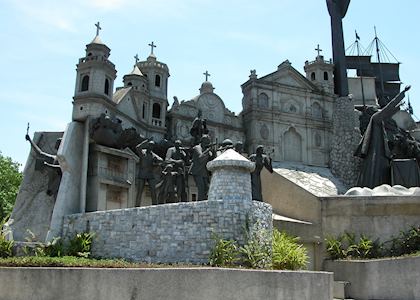
Visiting the Philippines in June
The rains make ground throughout the country, beginning in the north and gradually making their way south as the month goes on. Areas around Cebu should stay dry for most of the month.
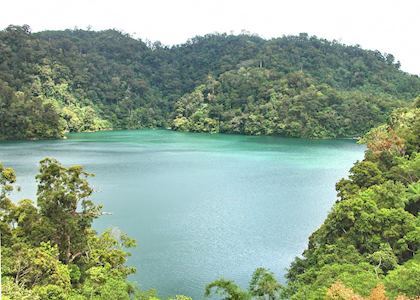
Visiting the Philippines in July
During July, the volume of rainfall increases throughout the country, with northern areas usually the most impacted. Central areas such as Cebu should still stay dry for the most part, with the odd shower expected.
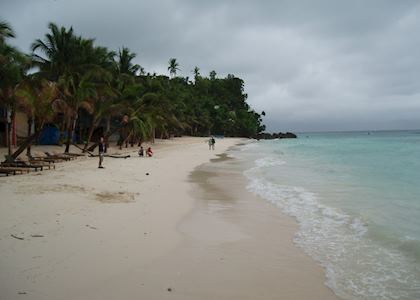
Visiting the Philippines in August
August is very much a similar story to July, and as the typhoon season begins toward the end of the month, it is probably best avoided.
Events & Festivals
- Kadayawan sa Davao (third week of August): A week-long harvest festival in Davao City, with civic parades, military parades, street dances and horsefighting.
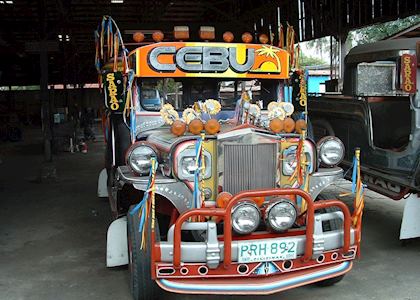
Visiting the Philippines in September
You should expect heavy rainfall throughout September, as well as the possibility of typhoons. We would therefore advise against travelling at this time.
Events & Festivals
- Peñafrancia Fluvial Festival (third Saturday of September): A sacred statue of Our Lady of Peñafrancia, the patron saint of Bicol, is paraded through the streets of Naga, then sailed down the Bicol River back to its shrine.
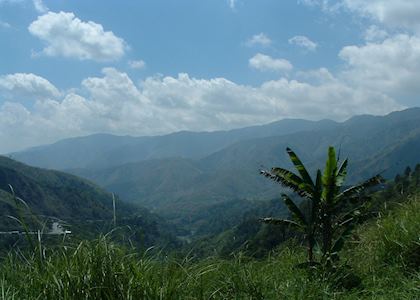
Visiting the Philippines in October
By the end of the month, most of the rains should have dispersed; however, there is still a chance of typhoons, and for this reason it may be best to travel at the end of the month or in early November.
Events & Festivals
- Ibalong (third week of October): Throughout Bicol and Legaspi, epic dances and street presentations portray Bicol’s mythical superheroes and gods.
- Kansilay (19th October, or closest weekend): A modern festival in Silay, Negros Occidental commemorating Silay’s charter day. Eating and drinking contests, beauty pageants and an elaborate street parade all take place.
- Lanzones Festival (third week of October): A vibrant and good-natured outdoor party in Lambajao, Camiguin, giving thanks for the island’s crop of lanzones (a tropical fruit).
- MassKara (third week of October): A festival in Bacolod featuring food fairs, mask-making contests and brass-band competitions, followed by a mardi-gras parade where revellers don elaborate masks and dance to Latin rhythms Rio de Janeiro-style.
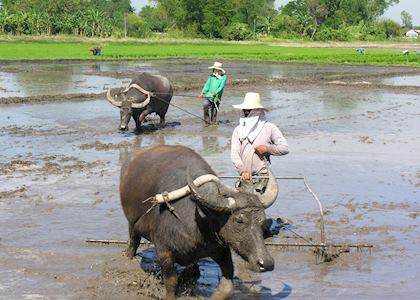
Visiting the Philippines in November
The official dry season begins again. However, there is still a chance of typhoons, so it may be best to travel toward the end of the month for a better chance of good weather.
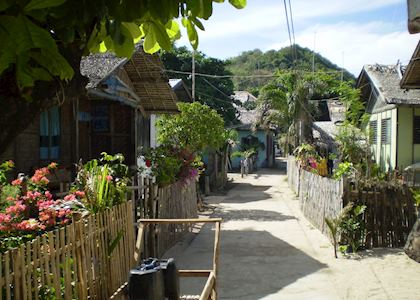
Visiting the Philippines in December
The cooler temperatures of December make for a pleasant time to travel, and although there is still a small chance of typhoons it marks the start of peak travel season.
Philippines Climate Guide
| Destination | Jan | Feb | Mar | Apr | May | Jun | Jul | Aug | Sep | Oct | Nov | Dec |
|---|---|---|---|---|---|---|---|---|---|---|---|---|
| Banaue | 24°C 45mm | 25°C 27mm | 26°C 78mm | 27°C 129mm | 27°C 231mm | 26°C 249mm | 25°C 326mm | 25°C 376mm | 25°C 315mm | 25°C 255mm | 25°C 266mm | 24°C 114mm |
| Bohol & Panglao Island | 30°C 133mm | 30°C 99mm | 31°C 92mm | 32°C 70mm | 33°C 99mm | 32°C 159mm | 32°C 142mm | 32°C 128mm | 32°C 139mm | 32°C 197mm | 31°C 222mm | 31°C 151mm |
| Boracay | 29°C 152mm | 30°C 74mm | 31°C 51mm | 32°C 67mm | 33°C 264mm | 32°C 334mm | 31°C 614mm | 31°C 506mm | 31°C 440mm | 31°C 448mm | 30°C 387mm | 29°C 253mm |
| Cebu | 30°C 104mm | 30°C 80mm | 31°C 59mm | 33°C 65mm | 33°C 115mm | 32°C 175mm | 32°C 191mm | 32°C 162mm | 32°C 174mm | 32°C 193mm | 31°C 166mm | 31°C 122mm |
| Manila | 30°C 16mm | 31°C 7mm | 32°C 11mm | 34°C 23mm | 34°C 124mm | 32°C 268mm | 31°C 387mm | 31°C 431mm | 31°C 335mm | 31°C 192mm | 31°C 133mm | 30°C 64mm |
| Palawan | 31°C 41mm | 31°C 21mm | 32°C 35mm | 33°C 46mm | 32°C 153mm | 31°C 175mm | 31°C 192mm | 31°C 197mm | 30°C 203mm | 31°C 227mm | 31°C 234mm | 31°C 165mm |
| Southern Luzon | 27°C 46mm | 28°C 24mm | 29°C 30mm | 31°C 50mm | 30°C 199mm | 29°C 293mm | 28°C 446mm | 27°C 451mm | 28°C 356mm | 28°C 240mm | 28°C 203mm | 27°C 128mm |
Why travel with Audley?
- 100% tailor-made tours
- Fully protected travel
- Established for over 25 years
- 98% of our clients would recommend us
Travel advice
Practical tips for travelling to the Philippines, from social protocols to guidance on money matters, with a link to the latest FCDO travel advice.

Request our brochure
Covering all seven continents, The World Your Way shows you how you can see the world with us. It features trip ideas from our specialists alongside hand-picked stays and experiences, and introduces our approach to creating meaningful travel experiences.
Trip ideas and travel guides for exploring the Philippines
-
![Church and convent, Siquijor]()
-
![Tarsier, Bohol]()
-
![Filipino boat in El Nido]()
-
What to do in the Philippines: our highlights guide ![Cambugahay Falls, Siquijor]()
What to do in the Philippines: our highlights guide
What to do in the Philippines: our highlights guide
Read this guide





